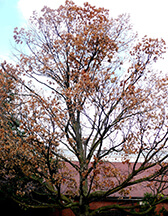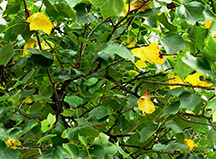Purdue experts: Tree deaths across Indiana may be related to weather stress
August 19, 2015
 |
|
Following excessive moisture this past spring, this sugar maple tree declined rapidly during hot and dry weather this summer. The combination of fungal dieback, environmental and site stress conditions over the past several years most likely contributed to the death of this tree. (Purdue Agricultural Communication photo/Keith Robinson) |
WEST LAFAYETTE, Ind. - Homeowners and landowners need to keep an eye on trees that may be dying from weather-related stress, Purdue University tree experts say.
Symptoms recently noted on mature oak, tulip and maple trees in Indiana include leaf scorch - the browning of leaves - branch dieback and premature defoliation.
Rosie Lerner, Purdue Extension consumer horticulture specialist, said healthy trees do not die quickly, and there are likely numerous stress factors adding to what is happening to some trees.
"Indiana weather has given us pretty much every extreme in the last few years from extreme heat and drought, to bitter cold and high winds and to floods," Lerner said. "The added stress, especially on urban trees that have compromised root systems, may make them more vulnerable than non-urban trees."
With the water levels in most counties in Indiana this year being above field capacity most of June and July, water stress is likely causing the symptoms, said Kyle Daniel, Extension horticulture program specialist.
 |
|
Homeowners with tulip poplar trees should not be overly concerned if they see some yellow leaves such as these. The random yellowing and premature leaf drop is common in the summer in trees with stressed root systems. (Purdue Agricultural Communication photo/Keith Robinson) |
"Tulip trees and most oaks can't tolerate flooded conditions, but certain maples, like silver maple, can tolerate compacted or flooded soil for a period of time," Daniel said
Lindsey Purcell, urban forestry specialist, wants owners of young and newly established trees to be aware that supplemental watering is essential if there is no rain for an extended amount of time, such as a week.
"These trees do not yet have the substantial root system to obtain water in drier conditions," he said.
Gail Ruhl, plant disease diagnostician, reminds those with trees experiencing these issues that it is crucial not to generalize the main cause of tree dieback but to examine each case with regard to specific symptoms and environmental elements.
"Stressed trees are more susceptible to insect and disease. In fact, stressed trees will attract secondary bark- and wood-boring beetles," Ruhl said.
Homeowners wanting to investigate the cause of their tree problems should use the Purdue Tree Doctor app available at Purdue Extension's The Education Store at www.edustore.purdue.edu and purdueplantdoctor.com.
Samples may be submitted to the Purdue Plant and Pest Diagnostic Lab for a professional diagnosis.
Writer: Aspen Deno, 765-496-2384, denoa@purdue.edu
Sources: Rosie Lerner, 765-494-1311, rosie@purdue.edu
Kyle Daniel, 765-494-7621, daniel38@purdue.edu
Lindsey Purcell, 765-494-3625, lapurcell@purdue.edu
Gail Ruhl, 765-494-4641, ruhlg@purdue.edu
Ag Communications: (765) 494-2722;
Keith Robinson, robins89@purdue.edu
Agriculture News Page

